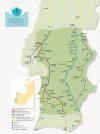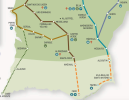- Time of past OR future Camino
- Some in the past; more in the future!
The Caminho Central is one of the three caminos being developed by the Caminhos de Santiago Alentejo e Ribatejo, a government-tourism project (along with the Caminho Nascente and Caminho da Raia). It begins in Faro on the Algarve coast of Portugal and ends in Santarém (about 20 stages by the looks of it), where it joins onto the main route of the Caminho Português from Lisbon.
Resources:
Official Site - includes GPS tracks and a free downloadable guide. The guide only covers the stages in the Alentejo and Ribatejo, but this is almost all of the camino, missing out only the first several stages in the Algarve.
Map - the Central is in brown:

Resources:
Official Site - includes GPS tracks and a free downloadable guide. The guide only covers the stages in the Alentejo and Ribatejo, but this is almost all of the camino, missing out only the first several stages in the Algarve.
Map - the Central is in brown:

Last edited:




















